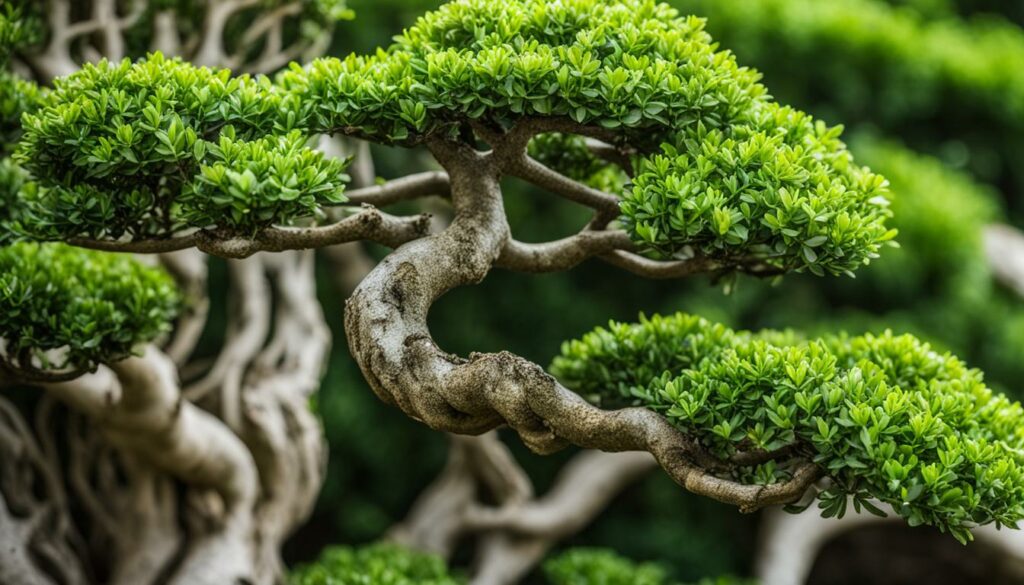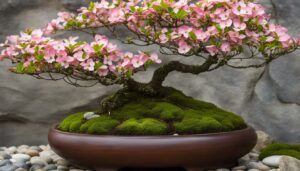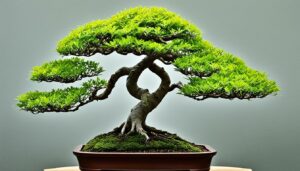If you’re considering growing a bonsai tree, Buxus can be an excellent choice for both new and experienced growers. Known as Boxwood, this species is a versatile option allowing for a wide range of styling techniques. By following proper care and maintenance practices, you can transform a Buxus tree into a stunning work of art.
In this guide, we’ll explore the different aspects of Buxus bonsai tree species, including its features, care requirements, and propagation tips. You’ll learn the different styling techniques and maintenance practices to keep your Buxus tree healthy and beautiful year-round.
Key Takeaways:
- Buxus is a versatile bonsai tree species that allows for various styling techniques.
- To maintain the year-round beauty of Buxus bonsai, proper care and maintenance are essential.
- Buxus propagation can be achieved through different methods, including seeds, cuttings, and layering.
- During winter, Buxus bonsai trees require extra care and protection from the adverse effects of cold weather.
- Displaying Buxus bonsai trees in suitable containers and stands can enhance their overall aesthetics.
Understanding Buxus Tree Species
Buxus tree species, commonly known as Boxwood, is one of the most versatile options for bonsai cultivation. Understanding its key characteristics and features will help you ensure proper Buxus care, giving your Boxwood bonsai a healthy and thriving growth.
Boxwood is an evergreen tree species that produces small, glossy leaves and delicate white flowers. It is a slow-growing tree that can reach up to 20 feet in height in its natural habitat. As a bonsai, Boxwood is known for its stable and compact growth habits, making it a favorite among bonsai enthusiasts.
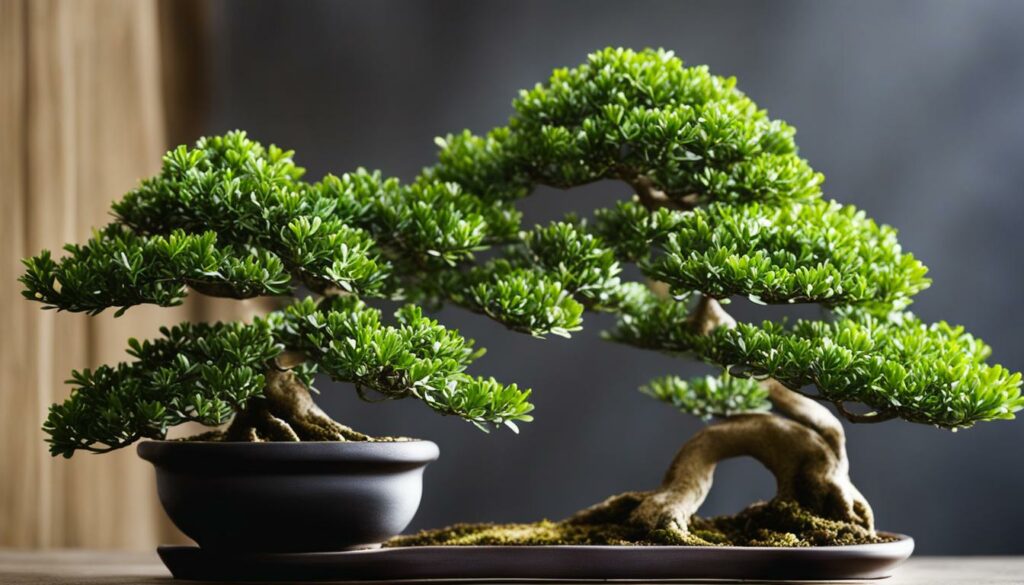
Buxus bonsai requires specific care and attention, especially regarding its watering, sunlight requirements, and soil conditions. Keeping the soil moist but not waterlogged is crucial to ensure a healthy balance of the tree’s nutrients. Your Boxwood bonsai requires moderate sunlight exposure to thrive. Taking care to shield your bonsai from direct sunlight, particularly during the hot summer months, is essential. The soil must be well-draining and nutrient-rich, providing the optimal conditions for healthy Boxwood growth.
Key Characteristics of Buxus Tree Species
| Characteristics | Description |
|---|---|
| Tree Size | Small to medium-sized tree species, can reach 20 feet in height in natural habitat. |
| Leaf Color | Small, glossy leaves in dark green or yellow-green. |
| Bloom Time | Produces delicate white flowers in the spring and summer. |
| Growth Habits | Stable and compact growth habits suitable for bonsai cultivation. |
Understanding the key aspects of caring for Buxus bonsai will ensure your Boxwood bonsai’s healthy growth and development. In the following section, we will discuss how to choose the right Buxus bonsai for your home or garden.
Choosing the Right Buxus Bonsai
When selecting a Buxus bonsai, consider the variety and your level of experience. Some Buxus bonsai varieties, such as the Japanese Boxwood and the English Boxwood, are more suitable for beginners due to their hardiness and adaptability.
On the other hand, experienced bonsai enthusiasts may opt for the Korean Boxwood or the Kingsville Dwarf, which require more specialized care, but offer unique and intricate styles.
To ensure the health of the Buxus bonsai, it’s essential to select a tree with strong roots and a well-developed trunk. Avoid Buxus bonsai with signs of disease or damage, such as yellowing leaves or broken branches.
Buxus Bonsai Variety Chart
| Buxus Bonsai Variety | Hardiness | Suitability for Beginners | Care Requirements |
|---|---|---|---|
| Japanese Boxwood (Buxus microphylla) | Zone 6-9 | Yes | Regular watering and pruning |
| English Boxwood (Buxus sempervirens) | Zone 5-8 | Yes | Well-draining soil and partial shade |
| Korean Boxwood (Buxus sinica var. insularis) | Zone 4-8 | No | Full sun and regular fertilization |
| Kingsville Dwarf Boxwood (Buxus microphylla var. japonica ‘Compacta’) | Zone 6-9 | No | Regular shaping and pruning |
Tip: When choosing a Buxus bonsai, observe the tree’s overall appearance and structure. Look for a streamlined form and a balanced distribution of foliage.
By selecting the right Buxus bonsai for your needs and experience level, you can ensure a successful and rewarding bonsai cultivation experience.
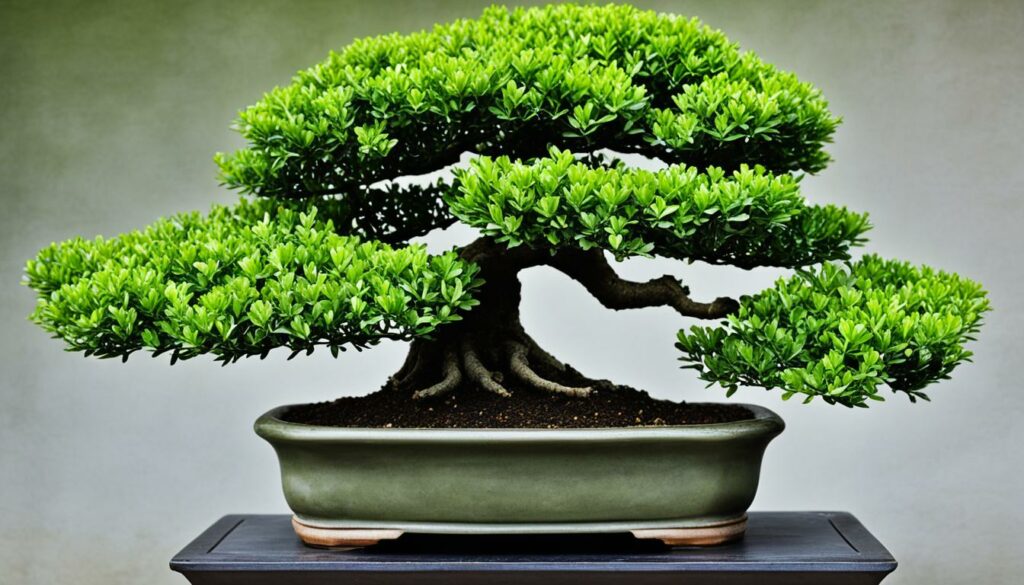
Buxus Bonsai Styling Techniques
Creating a desired shape and maintaining an overall aesthetic is an essential aspect of bonsai cultivation. Several styling techniques can be applied to shape and style the Buxus bonsai throughout its growth stages.
Pruning: Regular pruning is necessary for maintaining the shape and encouraging healthy growth of the Buxus bonsai. It involves removing unwanted branches, leaves, and buds. Pinching, which is the removal of new shoot tips, is also a common practice in Buxus bonsai pruning. Pinching encourages the growth of new branches and foliage, leading to a denser canopy.
Wiring: Wiring is a technique used to shape the trunk and branches of the Buxus bonsai. It involves wrapping wire around the branches and bending them gently into the desired shape. Bonsai wire should be wrapped in a spiral motion and removed after several months once the branches have set in their new position.
Shaping: Shaping involves manipulating the Buxus bonsai’s overall structure and form into the desired aesthetic. Different bonsai styles can be applied to shape the Buxus bonsai, such as formal upright, informal upright, cascading, and semi-cascade. The choice of style will depend on the characteristics of the Buxus bonsai and the preference of the bonsai enthusiast.
Remember that styling techniques should be applied gently and gradually to avoid any damage to the Buxus bonsai. The techniques can be applied throughout the year, depending on the growth stage of the bonsai.
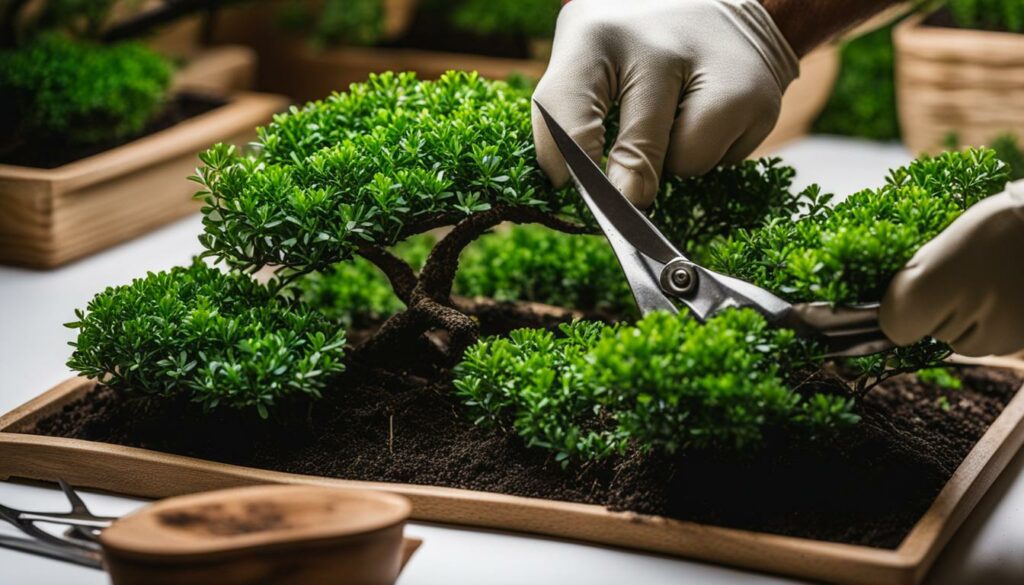
Buxus Bonsai Maintenance
Proper Buxus care is essential for maintaining the year-round beauty of your evergreen bonsai. Routine tasks such as watering, fertilizing, and repotting should be carried out consistently to promote healthy growth.
Watering: Buxus bonsai should be watered regularly, especially during the growing season. Check the soil daily and water when the top inch feels dry to the touch. Avoid overwatering as it can lead to root rot and other issues.
Fertilizing: Feed your Buxus bonsai with a balanced, slow-release fertilizer every four to six weeks during the growing season. Stop fertilizing during the winter months.
Repotting: Buxus bonsai should be repotted every two to three years to maintain healthy root growth. Repot in early spring using a well-draining soil mix.
If you encounter any issues with your Buxus bonsai, such as yellowing leaves or pests, take prompt action to resolve them. Common pests include spider mites, scale insects, and aphids.
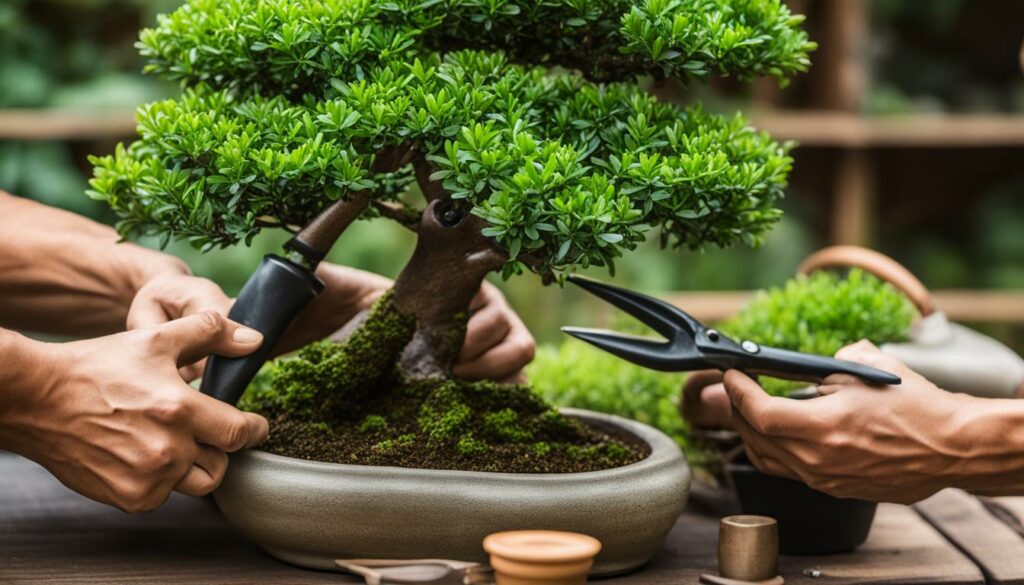
Buxus Bonsai Maintenance Tips:
- Water regularly, but avoid overwatering.
- Fertilize every four to six weeks during the growing season.
- Repot every two to three years using a well-draining soil mix.
- Take prompt action to resolve any issues or pests.
Overwintering Buxus Bonsai
Overwintering your Buxus bonsai is crucial to maintain its year-round beauty. Since Buxus is an evergreen bonsai tree, it needs adequate protection from extreme cold temperatures and harsh weather conditions during the winter months.
To care for your Buxus bonsai during winter, position it in a sheltered area, preferably near a wall that can provide extra protection from wind. Cover the soil with mulch or an insulating material like straw to keep the roots warm. Additionally, wrap the bonsai tree in burlap or breathable fabric to moderate temperature fluctuations and protect it from frost and snow damage.
While it’s important to shield your Buxus bonsai from the cold, remember to water it occasionally but sparingly to prevent the soil from completely drying out. Overwatering can lead to root rot, which can harm your bonsai tree.
In case you observe any issues like cracking bark or brown foliage, take prompt action by removing any dead or diseased branches and repotting with nutrient-rich soil. With proper care and attention, your Buxus bonsai can thrive in winter and continue to adorn your garden all year long.
Displaying Buxus Bonsai
Displaying your Buxus bonsai properly is an essential part of maintaining its aesthetic appeal. When choosing a container for your Buxus bonsai, consider its size and shape, ensuring it is appropriate to the tree’s growth and overall aesthetic. The container’s style should complement the bonsai and fit in the desired display area.
A display stand can elevate your Buxus bonsai and enhance its visual impact. Consider the stand’s style and color, ensuring that it accentuates the bonsai without drawing attention away from it.
Placement is crucial when displaying your Buxus bonsai. The evergreen nature of the Buxus tree species makes it an ideal indoor plant, and it can thrive in various light conditions. However, avoid placing it in direct sunlight, which can cause scorching and damage to its leaves.
To add more depth to the display, consider adding complementary accessories such as rocks, moss, or figurines. Ensure these accessories do not detract from the bonsai or overcomplicate the display.
Buxus Bonsai Display Tips:
- Choose a container that complements the bonsai’s size and shape
- Select a display stand that enhances the overall display without distracting from the bonsai
- Avoid direct sunlight and extreme temperatures when choosing a placement for your Buxus bonsai
- Complement the display with carefully chosen accessories
Propagation of Buxus Bonsai
Expanding your Buxus bonsai collection or sharing it with others is possible through propagation. There are three methods of propagation for Buxus bonsai – seeds, cuttings, and layering.
Seeds
Growing Buxus bonsai from seed is possible, but it is a slow process. It may take several years to produce a mature bonsai tree. To germinate Buxus seeds, first, soak them in water for 24 hours. Then, place them in seed trays with well-draining soil and keep them in a warm, bright location. Buxus seeds usually take several weeks to germinate.
Cuttings
Buxus bonsai can easily be propagated from cuttings. Cuttings should be taken from the woody part of a healthy branch. Dip the cut end in rooting hormone to stimulate growth and plant it in a well-draining soil mix. The cutting should be kept in a warm, humid place out of direct sunlight. After several weeks, it should develop roots and can be transplanted.
Layering
Layering is the process of growing roots from a branch that is still attached to the parent plant. To propagate Buxus bonsai through layering, choose a healthy, flexible branch and remove a ring of bark 2-3 inches wide. Apply rooting hormone to the exposed area and bury it in a pot filled with well-draining soil. Keep it well-watered and in a bright location. The branch will usually develop roots within a few weeks. Once it has a good system of roots, it can be cut off from the parent plant and potted as a new Buxus bonsai.
| Propagation Method | Advantages | Disadvantages |
|---|---|---|
| Seeds | Produces new genetic material; requires less skill than other methods | Slow process; may not develop into the desired Buxus bonsai form; requires patience and long-term commitment |
| Cuttings | Produces an exact match of the parent plant; quicker process than seeds | Requires some knowledge and skill; may not always work; may not produce new genetic material |
| Layering | Produces new genetic material; relatively quick process | Requires some skill and knowledge; may not always work |
Propagation is an excellent way to increase your Buxus bonsai collection or share it with others. With proper care and practice, anyone can successfully propagate Buxus bonsai using the three methods mentioned above. Happy propagating!
Conclusion
Congratulations! You’ve now learned all about Buxus bonsai species, the beautiful and versatile evergreen tree for bonsai cultivation. To ensure the year-round beauty of your Buxus bonsai, proper care and maintenance are essential. Remember to keep a watchful eye on the watering, soil, and sunlight requirements, and be sure to prune regularly to shape it according to your desired style.
Choosing the right Buxus bonsai and displaying it correctly are also key to enhancing its beauty, and propagating it can be a great way to expand your collection or share with others. And don’t forget about winter care – protecting your Buxus bonsai from extreme temperatures and adverse weather conditions during the colder months is crucial.
By following these tips and guidelines, you can ensure the health and longevity of your Buxus bonsai for years to come. Happy bonsai cultivating!
FAQ
What is a Buxus bonsai?
A Buxus bonsai refers to a bonsai tree that belongs to the Buxus tree species, commonly known as Boxwood. It is a small, carefully cultivated tree that resembles a mature Buxus tree in miniature form.
What are the care requirements for a Buxus bonsai?
Buxus bonsai requires regular watering, proper sunlight exposure, and well-draining soil. It is important to maintain a balance between keeping the soil moist and preventing waterlogging. Additionally, Buxus bonsai benefits from occasional pruning and shaping to maintain its desired form.
Can I keep a Buxus bonsai indoors?
While Buxus bonsai can tolerate indoor conditions, it is generally recommended to keep them outdoors. Buxus bonsai thrives when exposed to natural sunlight and proper air circulation. If kept indoors, ensure that the bonsai receives adequate light and fresh air to maintain its health.
How often should I fertilize my Buxus bonsai?
Buxus bonsai should be fertilized during the growing season, typically from early spring to late summer. Use a balanced bonsai fertilizer and follow the recommended dosage instructions. It is advisable to reduce or avoid fertilizing during winter and periods of dormancy.
What should I do if my Buxus bonsai gets affected by pests or diseases?
If your Buxus bonsai is affected by pests or diseases, it is crucial to identify the specific issue and take appropriate action. Consult a bonsai expert or a local nursery to determine the best course of treatment, which may involve using organic or chemical solutions, pruning affected parts, or improving the tree’s overall care.
